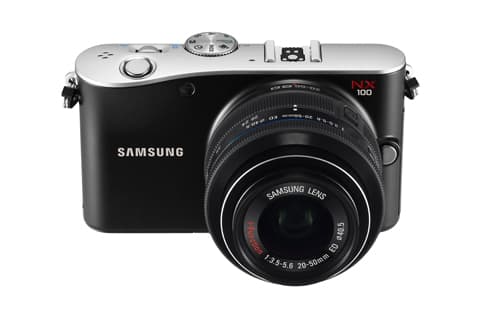Page One: Introduction

Samsung’s second micro system camera (MSC), the NX100 has much in common with its first, the NX10 (tested in AP 3 April 2010). Not least is the 14.6-million-pixel APS-C-sized CMOS sensor, which means that when the final full production model arrives it is highly likely that the quality of its images will be just as impressive as they are from the NX10.
The most notable differences between the NX100 and the older NX10 stem from the fact that the NX10 is designed upon mini-DSLR principles, whereas the NX100 has more compact camera type styling. According to Samsung’s President of Digital Imaging, SangJin Park, the inspiration for the design of the NX100 came from dew forming on a leaf. I can’t quite see it myself, but the NX100 is certainly a pretty little camera, that feels very nice in the hand.
Compact style
One consequence of the NX100’s sleeker, more compact design is that the fingergrip is much less pronounced, but I didn’t find this a significant issue when I used a pre-production sample over the few hours I had it my possession.
The smooth curve of the body provides just enough grip for the lightweight camera to be comfortable in my hand between shots. However, the fact there’s no viewfinder or built-in flash takes a little more getting over.
In the absence of a viewfinder, images are composed on the 3in 614,000dot (VGA) AMOLED screen, which provides a nice clear view of the scene. Those who can’t do without a viewfinder have the option of investing in the EVF10 electronic viewfinder. This is a 201,000dot (QVGA) device and although I want to use it a bit more before I am prepared to pass verdict on it, my first impressions are good.
An unfortunate downside of choosing to shoot using the EVF is that it occupies the hotshoe and hence precludes a flashgun from being mounted on the camera.
photokina 2010 news links:
- Sigma SD1 46 million pixel DSLR has new AF and larger sensor
- Leica-like Fuji X100 price and pictures
- Sony’s transulcent mirror A700 replacement?
- Panasonic GH2 – faster than a DSLR!
- Panasonic Lumix G 3D lens – pictures taken with it
- Ricoh’s 28mm lens for GXR
- Weather-proof Pentax 18-135mm lens
- Pentax K-5, the high speed camera
- UK price for Pentax 645D
- Panasonic 14mm pancake lens
- Nikon’s new D7000 DSLR
- The new Nikon SB-700 flash unit
- A new Nikon 35mm f/1.4 lens
- Nikon’s new 200mm f/2 lens
Page Two: Performance
 iFunction button
iFunction button
One of the benefits of producing a new line of cameras is that it gives the manufacturer the opportunity to take a fresh look at the configuration of the controls. Although it is possible to make all the usual adjustments – white balance, exposure and sensitivity and so on – using controls on the camera body, Samsung has introduced the ‘iFunction’ button to its newest NX lenses.
Pressing this button brings up a range of selectable features (white balance, aperture, exposure compensation and sensitivity) on the screen. Rotating the lens manual focus ring scrolls through the options and pressing the iFn button again makes the selection. It is a simple system that’s quick to use, although it took me quite a while to stop instinctively reaching for the navigation buttons on the camera body (which also work) instead of using the focus ring. Once the required setting has been selected and adjusted, pressing the iFn button again restores the lens ring to its normal function.
Performance
It would be unfair to draw many conclusions about the NX100’s performance from my experience with a preproduction model, but I was happy with the exposure and colour of the images I took. Most were taken in low light and required a burst of flash from a hotshoe mounted flash (I used the Samsung ED-SEF20A) and/or high sensitivity settings. The exposures are generally good and there’s little sign of chroma noise in the high-sensitivity JPEGs although, as with the NX10, this is at the expense of some detail.
New lenses
Samsung has introduced two new i-Function compatible lenses: a 20-50mm f/3.5-5.6 ED ‘standard’ zoom; and a 20mm f/2.8 pancake lens. I used the 20mm f/2.8 lens and it complements the compact dimensions of the NX100 beautifully. My only criticism is that the iFn button is a little too high on the barrel for my liking. With the camera held in the shooting position the iFn control sits at about the 10 O’clock point. I would prefer it a little lower, perhaps at the 9 O’clock point so that it is closer to the natural resting place for my left thumb. It is possible that Samsung has deliberately put the button in the higher location to avoid it being pressed accidentally though.
photokina 2010 news links:
- Sigma SD1 46 million pixel DSLR has new AF and larger sensor
- Leica-like Fuji X100 price and pictures
- Sony’s transulcent mirror A700 replacement?
- Panasonic GH2 – faster than a DSLR!
- Panasonic Lumix G 3D lens – pictures taken with it
- Ricoh’s 28mm lens for GXR
- Weather-proof Pentax 18-135mm lens
- Pentax K-5, the high speed camera
- UK price for Pentax 645D
- Panasonic 14mm pancake lens
- Nikon’s new D7000 DSLR
- The new Nikon SB-700 flash unit
- A new Nikon 35mm f/1.4 lens
- Nikon’s new 200mm f/2 lens







